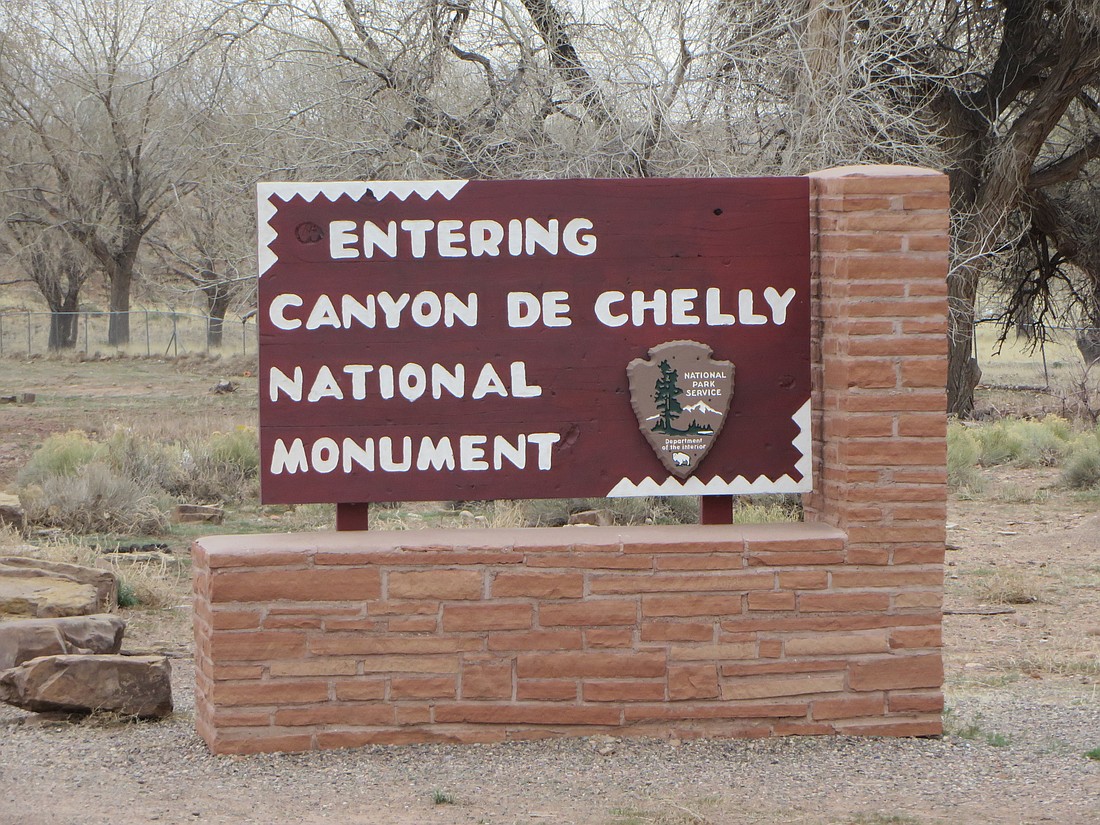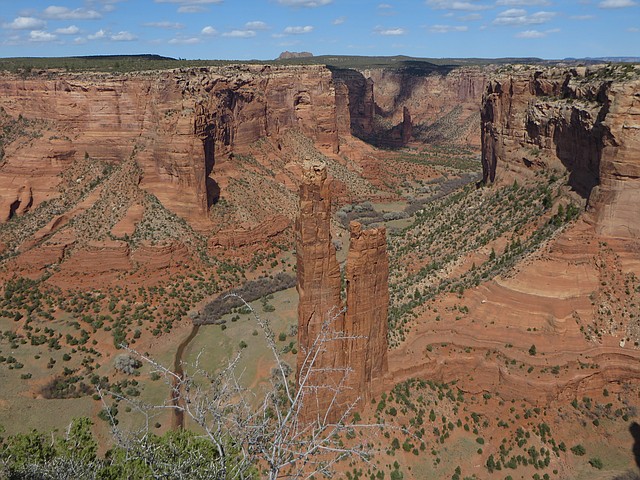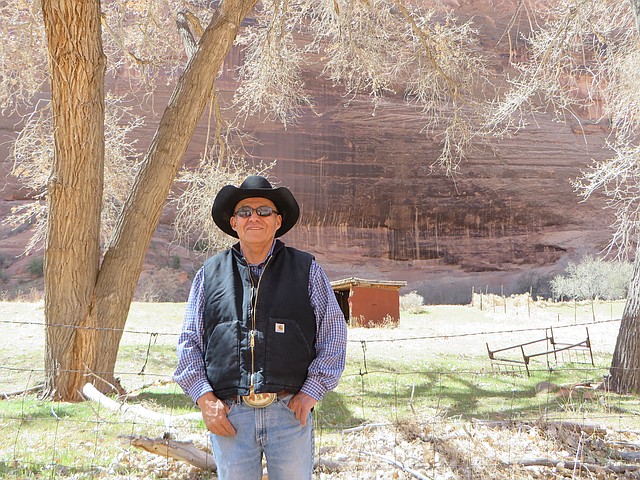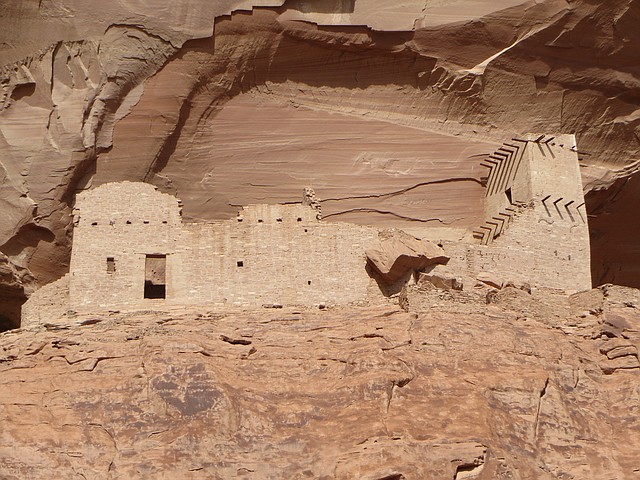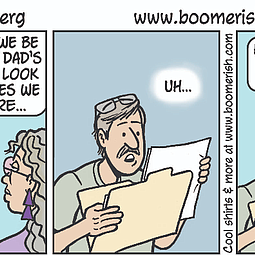If these walls could talk...
May 26, 2014 at 6:00 a.m.
Those who make the trip down into Canyon de Chelly in Chinle, AZ will often tell you it is one of the most memorable experiences in their lives. This natural wonder with its mesmerizing scenery and rich history creates a magical milieu that defies description.
Located in northeastern Arizona within the boundaries of the vast Navajo Nation, Canyon de Chelly is an 84,000-acre archeological sanctuary administered jointly by the National Park Service and the Navajo people. It was designated a national monument in 1931 to protect and preserve the numerous archeological resources long known to exist on the canyon rims, walls and bottomlands. The name was derived from the misspelling and mispronunciation of the Navajo word for the canyon, “Tseyi,” which is pronounced “say-ee.” Over time, the word became “de Chelly,” which is pronounced as “de-shay.”
The canyon, which is actually a labyrinth of several canyons, is composed of sandstone, and was created millions of years ago. Land uplifts and stream cutting formed the colorful sheer cliff walls that give the place its unique beauty. They rise dramatically, standing in some places over 1,000 feet above the canyon floor, overshadowing streams, cottonwoods, and small farms below. These spectacular vertical walls make access to the canyon bottom difficult, though this has long been viewed as an advantage as it has provided protection for both ancient and modern Native Americans throughout the centuries.
Natural water sources and an ideal soil composition provided a hospitable environment for flora and fauna to exist within the canyon, which eventually attracted the first human inhabitants to the area. The Ancient Pueblo people, or Anasazi as they are often referred to, found the canyons an ideal place to plant crops and raise families. They built multi-storied villages, small household compounds and kivas that dot the canyon alcoves and talus slopes. Their cliff dwellings took advantage of the sunlight and allowed for a natural system of heating and cooling. They also provided a natural form of protection, which was enhanced by the addition of accessible ladders that could be lifted during enemy attacks. Thanks to an arid climate and the shelter of the overhangs and caves, a number of the structures, along with other artifacts and organic remains, have been preserved. Of the total 2,700 ruins discovered in the canyon, 700 are still in some form of existence today.
The Anasazi thrived in the canyon until the mid-1300s when it is believed they left the area to seek better farmlands. This paved the way for the Hopi, descendants of the Anasazi, to migrate into the area. Though they had their fields of corn and fruit orchards within the canyon, the Hopi did not winter there, preferring to settle instead on the mesa tops.
In the 1700s, the Navajo settled in the Southwest and became residents of the canyon, where they continue to remain today. The canyon is the epicenter of Navajo culture. It is both the physical and spiritual home of the people. The Navajo, or Dine’ as they often call themselves, are related to the Athabaskan people of Northern Canada and Alaska. Like the “Ancient Ones,” they still plant their crops and fruit trees, raise livestock and build their hogans on the canyon floor. Roughly forty to fifty families currently live within the park borders.
It is unclear as to when the Europeans first became aware of this area, but a 1776 Spanish map includes the location of Canyon de Chelly. Soon after, Spanish troops entered the region and subjugated the Navajos. Pictographs on rock walls depict this event, providing evidence of its occurrence. Later, there were American military explorations and war campaigns against the Navajo and a history of rampant injustices and cruelty ensued. In 1849, James H. Simpson of the Corps of Topographical Engineers began recording several individual archeological finds in the canyon, including one he deemed Casa Blanca or White House because of a white-plastered room in its upper portion. Simpson is credited with noting similarities between the construction methods used in this region and those utilized in the pueblo ruins at New Mexico’s Chaco Canyon, 75 miles to the east.
Over the years, Canyon de Chelly became the focus of exploration and exploitation. By 1900, looting the ruins was a common practice, attracting both collectors and plunderers looking for treasure. Many artifacts were excavated and removed from various sites and subsequently sold to museums. It was only with the establishment of the American Antiquities Act in 1906 that such valuable relics were given statutory protection.
You can get spectacular views of the canyon from its numerous overlooks on the North and South Rim Drives, and you can access a small part of the canyon via the 2.5-mile round-trip White House Trail, which is the only public trail in the park. The switchback path leads you down 600 feet to the famed White House Ruin. No fee, permit or guide is required for either of these endeavors.
To truly experience this vast arena, however, you need to spend time inside its walls, traveling via vehicle, horseback or foot while in the accompaniment of an authorized Navajo guide.
There are a number of companies that offer guided services. Among them is the highly regarded Antelope House Tours, which is known for its knowledgeable and dedicated guides. Our group of five hired D.J., an older Navajo man with extensive guiding experience in the canyon. He picked us up in his trusty, road-weary Suburban and proceeded to drive us down into and through the expansive canyon. With D.J. at the wheel, we navigated the shallow rivers, thick mud and soft banks that often make travel within the gorge challenging. At times it appeared as if we might not make it any further due to the unstable conditions, but D.J. remained calm and collected and never failed to get us to the next juncture. When we encountered a younger guide in another vehicle who told D.J. that he wasn’t able to make it all the way to Mummy Cave, D.J. seemed undaunted and continued on ahead. Upon arriving at the obstacle in question, he appraised the situation, smiled and then put the pedal to the medal as we cheered him onward. It was obvious our seasoned guide wasn’t going to let anything stop him from getting us to one of the largest ancestral Puebloan villages in the canyon and a definite highlight of the tour. Mummy Cave was built in the 1280s by people who migrated from Mesa Verde. Its massive tower complex rests on a ledge with east and west alcoves that are comprised of living and ceremonial rooms.
It was clear that D.J. lived and breathed his culture and the canyon, often speaking about the place with awe and reverence. Though he has resided in the area his whole life, it still remains special to him and he never tires of sharing his “playground” with visitors. He regaled our group with the geology and history of the canyon and its people, and explained the meanings of the many petroglyphs and pictographs that decorated the rock walls. Additionally, he provided us with much information about the various plants, native and introduced, that are found in the canyon. As for animals, the list of those that make their home in the area is lengthy and includes such species as black bear, coyote, fox, mountain lion, bobcat, badger, raccoon, elk, snakes and others.
At various times during the tour, we got out of the car to obtain a closer look at the archeological remains. We also took a hike to experience the surroundings in a different way. On foot, the canyon’s rust-colored rock walls appeared as towering sentries, standing watch over a castle’s jewels. Imposing and grand, these giant monoliths made us humans feel very small and insignificant. A number of the formations resembled creatures. One looked like a cat; another, a coyote howling. And then there was one that we all decided was a dead-ringer for a frog.
Several landmarks have sad and disturbing histories. Massacre Cave, for example, refers to the Navajo killed there in the winter of 1805 by a Spanish military expedition. About 115 Navajo took shelter on the ledge above the canyon floor. They were eventually discovered by the soldiers and quickly massacred. Another, Fortress Rock, a giant butte with tall, steep sides, was the scene of a stand-off between the Navajo and the Indian fighter Kit Carson and his soldiers in 1863. The Navajo had sought refuge at the top of the rock, after stockpiling dried food inside storage bins built of stone and mud. Carson’s troops set fire to all the abandoned Navajo homes they could find, destroyed food supplies and filled up water holes with dirt. The Navajo realized they would not survive the winter and eventually came down from the rock to surrender, only to begin a forced several hundred mile trek to Fort Sumner. Their infamous journey became known as the Navajo Long Walk, a death march that killed thousands of people. Many grew sick and died; others froze or starved to death. Women who did not want to cross the raging Rio Grande River sacrificed themselves and their babies, disappearing into the fast-running waters. The ensuing years of internment for the Navajo at Fort Sumner were equally as devastating with inadequate food and shelter, as well as disease, brutalizing the survivors. Finally, in 1868, they were allowed to return home to rebuild their lives only to find their hogans, crops and sheep gone.
According to D.J., many Navajo people who spend time in the canyon tell stories of hearing voices from within its walls. They believe these are the sounds of their ancestors who suffered unspeakable harm. Such a haunting account, delivered by our Navajo guide in this place of remembrance, served to remind our group of the Native Americans’ tragic past and appalling treatment they received at the hands of our government.
There is much to learn from Canyon de Chelly and D.J. was an excellent teacher who helped history come alive for us. His invaluable knowledge and insights gave us a unique perspective, while deepening and personalizing our experience.
If you go:
For information about Canyon de Chelly: www.nps.gov/cach
Antelope House Tours: www.canyondechelly.net
Lodging options are limited to a few chain hotels in Chinle, right outside the park entrance.
The only accommodations within the park boundaries are at Sacred Canyon Lodge, a modest Navajo-run establishment: www.sacredcanyonlodge.com
Deborah Stone is a travel and lifestyle writer, who explores the globe in search of unique destinations and experiences to share with her readers. She’s an avid adventurer who welcomes new opportunities to increase awareness and enthusiasm for travel and cross-cultural connections. Her stories appear in a number of publications as well as on various travel websites. Additionally, she can be frequently be heard dishing travel with the hosts of the NPR-affiliated and AARP produced talk radio show, “2 Boomer Babes.” Deborah is a longtime Seattle area resident, who currently resides in Santa Fe, New Mexico.
